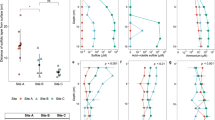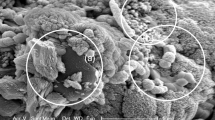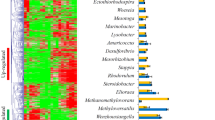Abstract
A pilot-scale field test system with an inner loop nested within an outer loop was constructed for in situ U(VI) bioremediation at a US Department of Energy site, Oak Ridge, TN. The outer loop was used for hydrological protection of the inner loop where ethanol was injected for biostimulation of microorganisms for U(VI) reduction/immobilization. After 2 years of biostimulation with ethanol, U(VI) levels were reduced to below drinking water standard (<30 μg l−1) in the inner loop monitoring wells. To elucidate the microbial community structure and functions under in situ uranium bioremediation conditions, we used a comprehensive functional gene array (GeoChip) to examine the microbial functional gene composition of the sediment samples collected from both inner and outer loop wells. Our study results showed that distinct microbial communities were established in the inner loop wells. Also, higher microbial functional gene number, diversity and abundance were observed in the inner loop wells than the outer loop wells. In addition, metal-reducing bacteria, such as Desulfovibrio, Geobacter, Anaeromyxobacter and Shewanella, and other bacteria, for example, Rhodopseudomonas and Pseudomonas, are highly abundant in the inner loop wells. Finally, the richness and abundance of microbial functional genes were highly correlated with the mean travel time of groundwater from the inner loop injection well, pH and sulfate concentration in groundwater. These results suggest that the indigenous microbial communities can be successfully stimulated for U bioremediation in the groundwater ecosystem, and their structure and performance can be manipulated or optimized by adjusting geochemical and hydrological conditions.
Similar content being viewed by others
Log in or create a free account to read this content
Gain free access to this article, as well as selected content from this journal and more on nature.com
or
References
Akob DM, Mills HJ, Gihring TM, Kerkhof L, Stucki JW, Anastacio AS et al. (2008). Functional diversity and electron donor dependence of microbial populations capable of U(VI) reduction in radionuclide-contaminated subsurface sediments. Appl Environ Microbiol 74: 3159–3170.
Akob DM, Mills HJ, Kostka JE . (2007). Metabolically active microbial communities in uranium-contaminated subsurface sediments. FEMS Microbiol Ecol 59: 95–107.
Amos BK, Sung Y, Fletcher KE, Gentry TJ, Wu WM, Criddle CS et al. (2007). Detection and quantification of Geobacter lovleyi strain SZ: implications for bioremediation at tetrachloroethene- and uranium-impacted sites. Appl Environ Microbiol 73: 6898–6904.
Anderson RT, Vrionis HA, Ortiz-Bernad I, Resch CT, Long PE, Dayvault R et al. (2003). Stimulating the in situ activity of Geobacter species to remove uranium from the groundwater of a uranium-contaminated aquifer. Appl Environ Microbiol 69: 5884–5891.
Bender J, Duff MC, Phillips P, Hill M . (2000). Bioremediation and bioreduction of dissolved U(VI) by microbial mat consortium supported on silica gel particles. Environ Sci Technol 34: 3235–3241.
Bostick BC, Fendorf S, Barnett MO, Jardine PM, Brooks SC . (2002). Uranyl surface complexes formed on subsurface media from DOE facilities. Soil Sci Soc Am J 66: 99–108.
Brodie EL, DeSantis TZ, Joyner DC, Baek SM, Larsen JT, Andersen GL et al. (2006). Application of a high-density oligonucleotide microarray approach to study bacterial population dynamics during uranium reduction and reoxidation. Appl Environ Microbiol 72: 6288–6298.
Cardenas E, Wu WM, Leigh MB, Carley J, Carroll S, Gentry T et al. (2008). Microbial communities in contaminated sediments, associated with bioremediation of uranium to submicromolar levels. Appl Environ Microbiol 74: 3718–3729.
Finneran KT, Housewright ME, Lovley DR . (2002). Multiple influences of nitrate on uranium solubility during bioremediation of uranium-contaminated subsurface sediments. Environ Microbiol 4: 510–516.
Gentry TJ, Wickham GS, Schadt CW, He Z, Zhou J . (2006). Microarray applications in microbial ecology research. Microb Ecol 52: 159–175.
Gu BH, Wu WM, Ginder-Vogel MA, Yan H, Fields MW, Zhou J et al. (2005). Bioreduction of uranium in a contaminated soil column. Environ Sci Technol 39: 4841–4847.
Hazen TC, Tabak HH . (2005). Developments in bioremediation of soils and sediments polluted with metals and radionuclides: 2. Field research on bioremediation of metals and radionuclides. Rev Environ Sci Biotechnol 4: 157–183.
He ZL, Gentry TJ, Schadt CW, Wu LY, Liebich J, Chong SC et al. (2007). GeoChip: a comprehensive microarray for investigating biogeochemical, ecological and environmental processes. ISME J 1: 67–77.
Holmes DE, Finneran KT, O’Neil RA, Lovley DR . (2002). Enrichment of members of the family Geobacteraceae associated with stimulation of dissimilatory metal reduction in uranium-contaminated aquifer sediments. Appl Environ Microbiol 68: 2300–2306.
Hwang C, Wu WM, Gentry TJ, Carley J, Carroll SL, Watson D et al. (2009). Bacterial community succession during in situ uranium bioremediation: spatial similarities along controlled flow paths. ISME J 3: 47–64.
Istok JD, Senko JM, Krumholz LR, Watson D, Bogle MA, Peacock A et al. (2004). In situ bioreduction of technetium and uranium in a nitrate-contaminated aquifer. Environ Sci Technol 38: 468–475.
Larimer FW, Chain P, Hauser L, Lamerdin J, Malfatti S, Do L et al. (2004). Complete genome sequence of the metabolically versatile photosynthetic bacterium Rhodopseudomonas palustris. Nat Biotechnol 22: 55–61.
Liu CX, Zachara JM, Zhong LR, Kukkadupa R, Szecsody JE, Kennedy DW . (2005). Influence of sediment bioreduction and reoxidation on uranium sorption. Environ Sci Technol 39: 4125–4133.
Lovley DR . (1991). Dissimilatory Fe(III) and Mn(Iv) reduction. Microbiol Rev 55: 259–287.
Lovley DR . (2003). Cleaning up with genomics: applying molecular biology to bioremediation. Nat Rev Microbiol 1: 35–44.
Lovley DR, Phillips EJP . (1992). Reduction of uranium by Desulfovibrio desulfuricans. Appl Environ Microbiol 58: 850–856.
Lovley DR, Phillips EJP, Gorby YA, Landa ER . (1991). Microbial reduction of uranium. Nature 350: 413–416.
Luo J, Cripka OA, Wu WM, Fienen MN, Jardine PM, Mehlhorn TL et al. (2005). Mass-transfer limitations for nitrate removal in a uranium-contaminated. Environ Sci Technol 39: 8453–8459.
Luo J, Wu WM, Carley J, Ruan C, Gu B, Jardine PM et al. (2007). Hydraulic performance analysis of a multiple injection–extraction well system. J Hydrol 336: 294–302.
Luo J, Wu WM, Fienen MN, Jardine PM, Mehlhorn TL, Watson DB et al. (2006). A nested-cell approach for in situ remediation. Ground Water 44: 266–274.
Nevin KP, Finneran KT, Lovley DR . (2003). Microorganisms associated with uranium bioremediation in a high-salinity subsurface sediment. Appl Environ Microbiol 69: 3672–3675.
North NN, Dollhopf SL, Petrie L, Istok JD, Balkwill DL, Kostka JE . (2004). Change in bacterial community structure during in situ biostimulation of subsurface sediment cocontaminated with uranium and nitrate. Appl Environ Microbiol 70: 4911–4920.
Nyman J, Gentile M, Criddle C . (2007). Sulfate requirement for the growth of U(VI)-reducing bacteria in an ethanol-fed enrichment. Bioremed J 11: 21–32.
Payne RB, Gentry DM, Rapp-Giles BJ, Casalot L, Wall JD . (2002). Uranium reduction by Desulfovibrio desulfuricans strain G20 and a cytochrome c3 mutant. Appl Environ Microbiol 68: 3129–3132.
Ramette A . (2007). Multivariate analyses in microbial ecology. FEMs Microbiol Ecol 62: 142–160.
Ramette A, Tiedje JM . (2007). Multiscale response of microbial life in spatial distance and environmental heterogeneity in a patchy ecosystem. Proc Natl Acad Sci USA 104: 2761–2766.
Rhee SK, Liu XD, Wu LY, Chong SC, Wan XF, Zhou JZ . (2004). Detection of genes involved in biodegradation and biotransformation in microbial communities by using 50-mer oligonucleotide microarrays. Appl Environ Microbiol 70: 4303–4317.
Sanford RA, Wu Q, Sung Y, Thomas SH, Amos BK, Prince EK et al. (2007). Hexavalent uranium supports growth of Anaeromyxobacter dehalogenans and Geobacter spp. with lower than predicted biomass yields. Environ Microbiol 9: 2885–2893.
Spear JR, Figueroa LA, Honeyman BD . (2000). Modeling reduction of uranium U(VI) under variable sulfate concentrations by sulfate-reducing bacteria. Appl Environ Microbiol 66: 3711–3721.
Tabak HH, Lens P, van Hullebusch ED, Dejonghe W . (2005). Developments in bioremediation of soils and sediments polluted with metals and radionuclides—1. Microbial processes and mechanisms affecting bioremediation of metal contamination and influencing metal toxicity and transport. Rev Environ Sci Biotechnol 4: 115–156.
Van Nostrand JD, Wu WM, Wu L, Deng Y, Carley J, Carroll S et al. (2009). GeoChip-based analysis of functional microbial communities during the reoxidation of a bioreduced uranium-contaminated aquifer. Environ Microbiol 11: 2611.
Waldron PJ, Van Nostrand JD, Watson DB, He Z, Wu L, Jardine PM et al. (2009). Functional gene array-based analysis of microbial community structure in groundwaters with a gradient of contaminant levels. Environ Sci Technol 43: 3529–3534.
Wall JD, Krumholz LR . (2006). Uranium reduction. Annu Rev Microbiol 60: 149–166.
Wang F, Zhou H, Meng J, Peng X, Jiang L, Sun P et al. (2009). GeoChip-based analysis of metabolic diversity of microbial communities at the Juan de Fuca Ridge hydrothermal vent. Proc Natl Acad Sci USA 106: 4840–4845.
Wu LY, Liu X, Schadt CW, Zhou JZ . (2006a). Microarray-based analysis of subnanogram quantities of microbial community DNAs by using whole-community genome amplification. Appl Environ Microbiol 72: 4931–4941.
Wu LY, Thompson DK, Li GS, Hurt RA, Tiedje JM, Zhou JZ . (2001). Development and evaluation of functional gene arrays for detection of selected genes in the environment. Appl Environ Microbiol 67: 5780–5790.
Wu Q, Sanford RA, Loffler FE . (2006b). Uranium(VI) reduction by Anaeromyxobacter dehalogenans strain 2CP-C. Appl Environ Microbiol 72: 3608–3614.
Wu WM, Carley J, Fienen M, Mehlhorn T, Lowe K, Nyman J et al. (2006c). Pilot-scale in situ bioremediation of uranium in a highly contaminated aquifer. 1. Conditioning of a treatment zone. Environ Sci Technol 40: 3978–3985.
Wu WM, Carley J, Gentry T, Ginder-Vogel MA, Fienen M, Mehlhorn T et al. (2006d). Pilot-scale in situ bioremediation of uranium in a highly contaminated aquifer. 2. Reduction of U(VI) and geochemical control of U(VI) bioavailability. Environ Sci Technol 40: 3986–3995.
Wu WM, Carley J, Luo J, Ginder-Vogel MA, Cardenas E, Leigh MB et al. (2007). In situ bioreduction of uranium (VI) to submicromolar levels and reoxidation by dissolved oxygen. Environ Sci Technol 41: 5716–5723.
Zhou JZ . (2003). Microarrays for bacterial detection and microbial community analysis. Curr Opin Microbiol 6: 288–294.
Zhou JZ, Bruns MA, Tiedje JM . (1996). DNA recovery from soils of diverse composition. Appl Environ Microbiol 62: 316–322.
Zhou JZ, Kang S, Schadt CW, Garten CT . (2008). Spatial scaling of functional gene diversity across various microbial taxa. Proc Natl Acad Sci USA 105: 7768–7773.
Acknowledgements
We thank Tonia Mehlhorn, Sue Carroll and Kenneth Lowe for sampling and analytical help. This work was a part of the Virtual Institute for Microbial Stress and Survival (http://VIMSS.lbl.gov) supported by the US Department of Energy, Office of Science, Office of Biological and Environmental Research, Genomics Program: GTL through contract DE-AC02-05CH11231 between Lawrence Berkeley National Laboratory and the US Department of Energy, the Oklahoma Center for the Advancement of Science and Technology under Oklahoma Applied Research Support Program, and by the Team Project of the Natural Science Foundation of Guangdong, China (9351007002000001).
Author information
Authors and Affiliations
Corresponding author
Additional information
Supplementary Information accompanies the paper on The ISME Journal website
Supplementary information
Rights and permissions
About this article
Cite this article
Xu, M., Wu, WM., Wu, L. et al. Responses of microbial community functional structures to pilot-scale uranium in situ bioremediation. ISME J 4, 1060–1070 (2010). https://doi.org/10.1038/ismej.2010.31
Received:
Accepted:
Published:
Issue date:
DOI: https://doi.org/10.1038/ismej.2010.31
Keywords
This article is cited by
-
Risk of colloidal and pseudo-colloidal transport of actinides in nitrate contaminated groundwater near a radioactive waste repository after bioremediation
Scientific Reports (2022)
-
Fluoride contributes to the shaping of microbial community in high fluoride groundwater in Qiji County, Yuncheng City, China
Scientific Reports (2019)
-
Insights from the Genomes of Microbes Thriving in Uranium-Enriched Sediments
Microbial Ecology (2018)
-
The shifts of sediment microbial community phylogenetic and functional structures during chromium (VI) reduction
Ecotoxicology (2016)
-
Seasonal Changes in Bacterial Communities Cause Foaming in a Wastewater Treatment Plant
Microbial Ecology (2016)



